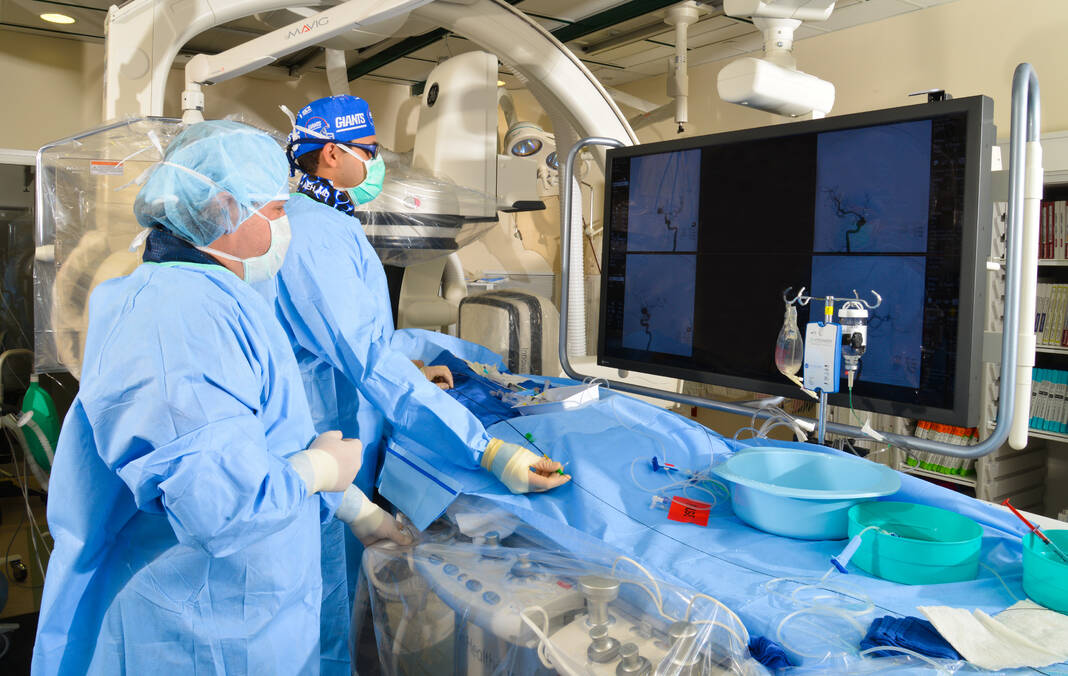|
Only have a minute? Listen instead
Getting your Trinity Audio player ready...
|
HARLINGEN — Strokes affect women differently from men because of varying hormones at different ages.
Dr. Victoria Parada, a neurologist at the neuroscience unit at Valley Baptist Medical Center, delivered that message May 3 and 4 at the Eighth Annual South Comprehensive Stroke Care Symposium on South Padre Island.
“Women have a greater lifetime risk of stroke,” Parada told attendees of the Symposium. “Stroke is the fifth cause of death in women, and one in five women have a stroke between ages 55 and 75.”
May is National Stroke Awareness Month, and the Symposium hosted medical professionals from across the United States who gave presentations related to stroke.
Dr. Shazam Hussain, of Cleveland, spoke about a mobile stroke unit. Dr. Mikayel Girgorian, of Miami, talked about the evolution of stroke treatment. Dr. Ameer Hassan, head of the neuroscience department at Valley Baptist Medical Center, talked about the use of artificial intelligence in stroke care.
“Artificial intelligence is not just keeping pace but staying two steps ahead in managing complex stroke cases,” Hassan said. “By rapidly analyzing brain imaging results, AI alerts healthcare teams to critical changes, allowing for quicker diagnosis and interventions.”
Parada spoke about strokes in women. She told the group that 60% of stroke-related deaths are women.
“When you look at these numbers, stroke kills more women than breast cancer every year,” she said. “The major risk factors for stroke are similar between women and men, but the frequency of each risk factor differs along a woman’s lifetime and is related the unique impact of natural estrogen in women’s bodies at different ages.”
Stroke is a type of cardiovascular disease which affects the arteries leading to the brain and the arteries within the brain, Hassan said.

“A stroke occurs when a blood vessel that carries oxygen and nutrients to the brain is either blocked by a clot or bursts,” Hassan said. “When that happens, part of the brain cannot get the blood and oxygen it needs, and that part of the brain starts to die.”
Any discussion of stroke must begin with recognizing symptoms. Doctors everywhere use the acronym F.A.S.T. for people to remember those signs and symptoms and the action required.
F.A.S.T stands for Face, Arms, Speech, and Time.
Face refers to the drooping of one side of the face, indicating a possible stroke. If the individual raises his arms and one drifts downward, that’s another sign. Speech? If the person’s speech is slurred or otherwise disrupted, that’s also a sign of a stroke.
And then there’s time. Get the patient to the hospital immediately, Hassan said.
“It’s important to recognize these signs that a stroke is happening, because you can save a life,” Hassan said. “The point to remember is that ‘time equals brain.’ A delay of even five or ten minutes can make a big difference in the patient’s outcome. Every minute in delay to treatment leads to two million neurons dying.”
Stroke is the number one cause of long-term disabilities, said the Symposium’s overview.
“Stroke treatment and prevention is especially important in deep South Texas where 90 percent of the population is Hispanic, six times the national average,” according to the Symposium. “Such statistics mean local populations have a high rate of diabetes and hypertension, which are risk factors for stroke.”
Hassan said the Valley has almost double the rate of diabetes compared to national averages, and he cited diet and lifestyle as contributing factors. The best way to reduce the rate of stroke is through diet and exercise.
A change in diet should include less red meat, pork and fried foods and more fish, fruits and vegetables. A daily regimen of exercise is also important. Hassan said people should get thirty minutes of exercise a day at least five days a week.
Even so, stroke can affect anyone for any number of reasons, and physicians everywhere are finding new ways to keep strokes from endangering lives or causing long-term disabilities.
The Centers for Disease Control and Prevention says the public is becoming more aware of stroke, the symptoms of stroke, and the importance of rapid response.
However, patients ignoring symptoms still happen, and the result is long-term disability that can easily be avoided, said Dr. Luis Gaitan, medical director of the Stroke Program at Valley Baptist Medical Center-Brownsville.
“You should never delay stroke care, because if caught early, stroke is usually very treatable,” Gaitan said. “Unnecessary delays in treatment put positive outcomes in jeopardy.”
Everyday, advances in stroke care improve outcomes, providing for a full recovery with no permanent disability.
Valley Baptist Medical Center in both Harlingen and Brownsville use a clot-busting medication called TPA – tissue plasminogen activator. In most cases, that medication must be given within three hours after symptoms appear, Gaitan said.
“Valley Baptist-Brownsville continues to strive for excellence in the acute treatment of stroke patients, and part of that effort is making sure our patients are receiving the appropriate care as quickly as possible,” he said. “When it comes to treating a stroke, every second counts.”
VBMC–Harlingen also offers endovascular stroke treatments in which blood clots are extracted with tiny mechanical devices.
The F.A.S.T. acronym makes it easier to remember what to look for. Many physicians have added B.E., which stands for Balance and Eyes, referring to blurred vision.
The message this month and throughout the year is to BE FAST when dealing with stroke.




